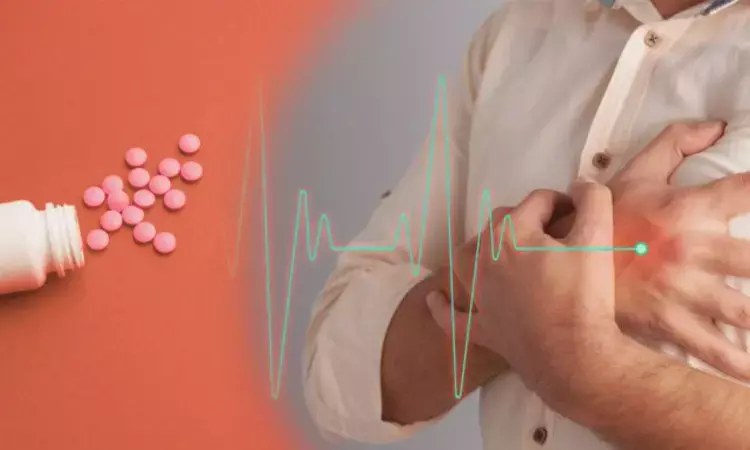- Home
- Medical news & Guidelines
- Anesthesiology
- Cardiology and CTVS
- Critical Care
- Dentistry
- Dermatology
- Diabetes and Endocrinology
- ENT
- Gastroenterology
- Medicine
- Nephrology
- Neurology
- Obstretics-Gynaecology
- Oncology
- Ophthalmology
- Orthopaedics
- Pediatrics-Neonatology
- Psychiatry
- Pulmonology
- Radiology
- Surgery
- Urology
- Laboratory Medicine
- Diet
- Nursing
- Paramedical
- Physiotherapy
- Health news
- Fact Check
- Bone Health Fact Check
- Brain Health Fact Check
- Cancer Related Fact Check
- Child Care Fact Check
- Dental and oral health fact check
- Diabetes and metabolic health fact check
- Diet and Nutrition Fact Check
- Eye and ENT Care Fact Check
- Fitness fact check
- Gut health fact check
- Heart health fact check
- Kidney health fact check
- Medical education fact check
- Men's health fact check
- Respiratory fact check
- Skin and hair care fact check
- Vaccine and Immunization fact check
- Women's health fact check
- AYUSH
- State News
- Andaman and Nicobar Islands
- Andhra Pradesh
- Arunachal Pradesh
- Assam
- Bihar
- Chandigarh
- Chattisgarh
- Dadra and Nagar Haveli
- Daman and Diu
- Delhi
- Goa
- Gujarat
- Haryana
- Himachal Pradesh
- Jammu & Kashmir
- Jharkhand
- Karnataka
- Kerala
- Ladakh
- Lakshadweep
- Madhya Pradesh
- Maharashtra
- Manipur
- Meghalaya
- Mizoram
- Nagaland
- Odisha
- Puducherry
- Punjab
- Rajasthan
- Sikkim
- Tamil Nadu
- Telangana
- Tripura
- Uttar Pradesh
- Uttrakhand
- West Bengal
- Medical Education
- Industry
Dapagliflozin Enhances Right Ventricular Function in Heart Failure Patients, shows study

USA: Dapagliflozin enhances right ventricular pulsatile afterload and myocardial performance during exercise, which correlates with a reduction in pulmonary capillary wedge pressure (PCWP), a secondary analysis of a randomized clinical trial including 37 participants has found.
Dapagliflozin demonstrated improvements in pulsatile pulmonary vascular load and right ventricular function during exercise, marked by significant enhancements in pulmonary artery (PA) compliance, PA pulsatility index, PA elastance, and right ventricular-PA coupling, the researchers reported in JAMA Cardiology.
They noted that these changes were correlated with a decrease in pulmonary capillary wedge pressure reduction, demonstrating the benefit of PCWP reduction on pulsatile right ventricular afterload in heart failure with preserved ejection fraction (HFpEF).
Increases in PCWP during exercise reduce PA compliance, increase pulsatile right ventricular (RV) afterload, and impair RV-PA coupling in HFpEF patients. The impact of the sodium-glucose cotransporter 2 (SGLT2) inhibitor dapagliflozin on pulmonary vascular properties and right ventricular-pulmonary artery (RV-PA) coupling has not been studied.
To fill this knowledge gap, Yogesh N. V. Reddy, Department of Cardiovascular Medicine, Mayo Clinic and Foundation, Rochester, Minnesota, and colleagues test the dapagliflozin's effect on right ventricular performance and pulmonary vascular load during exertion in HFpEF.
The CAMEO-DAPA randomized clinical trial, conducted between February 2021 and May 2022, assessed the cardiac and metabolic effects of dapagliflozin in patients with HFpEF. The study revealed significant improvements in pulmonary capillary wedge pressure (PCWP) at both rest and during exercise over the 24 weeks compared to placebo.
The secondary analysis focused on evaluating how dapagliflozin affects pulsatile pulmonary vascular load and right ventricular-pulmonary artery (RV-PA) coupling. The evaluation utilized simultaneous echocardiography and high-fidelity invasive hemodynamic testing during exercise. The study was conducted at a single center and included patients with confirmed HFpEF with an exercise PCWP of 25 mm Hg or higher.
Participants in the trial received either dapagliflozin or a placebo for 24 weeks. The primary outcomes measured were pulsatile pulmonary vascular load indicators such as pulmonary artery (PA) compliance and elastance, as well as markers of right ventricular performance, including PA pulsatility index and RV systolic velocity (s') relative to PA mean pressure, both at rest and during exercise.
The following were the key findings of the study:
- Among 37 randomized participants (mean age, 67.4 years; 65% females; mean body mass index, 34.9; calculated as weight in kilograms divided by height in meters squared), there was no effect of dapagliflozin on PA loading or RV-PA interaction at rest.
- With exercise, dapagliflozin improved PA compliance (placebo-corrected mean difference, 0.57 mL/mm Hg) and decreased PA elastance (stiffness; −0.17 mm Hg/mL).
- RV function during exercise improved, with an increase in PA pulsatility index (0.33) and an increase in exercise RV s′ indexed to PA pressure (0.09 cm·s−1/mm Hg).
- Improvements in pulsatile RV load and RV-PA coupling correlated with a reduction in right atrial (RA) pressure and PCWP.
- Dapagliflozin increased resistance-compliance time (dapagliflozin, median change, 0.06 seconds; placebo, median change, 0.01 seconds), resulting in higher PA compliance for any exercise pulmonary vascular resistance.
The findings from the randomized clinical trial indicate that dapagliflozin treatment over 24 weeks decreased pulsatile pulmonary vascular load and improved the interaction between the right ventricle and pulmonary artery during exercise in patients with HFpEF.
"These improvements were associated with a reduction in PCWP. The enhanced dynamic coupling between the right ventricle and pulmonary vasculature may contribute to the observed benefits of SGLT2 inhibitors in HFpEF," the researchers concluded.
Reference:
Reddy YNV, Carter RE, Sorimachi H, et al. Dapagliflozin and Right Ventricular–Pulmonary Vascular Interaction in Heart Failure With Preserved Ejection Fraction: A Secondary Analysis of a Randomized Clinical Trial. JAMA Cardiol. Published online July 24, 2024. doi:10.1001/jamacardio.2024.1914
Dr Kamal Kant Kohli-MBBS, DTCD- a chest specialist with more than 30 years of practice and a flair for writing clinical articles, Dr Kamal Kant Kohli joined Medical Dialogues as a Chief Editor of Medical News. Besides writing articles, as an editor, he proofreads and verifies all the medical content published on Medical Dialogues including those coming from journals, studies,medical conferences,guidelines etc. Email: drkohli@medicaldialogues.in. Contact no. 011-43720751


